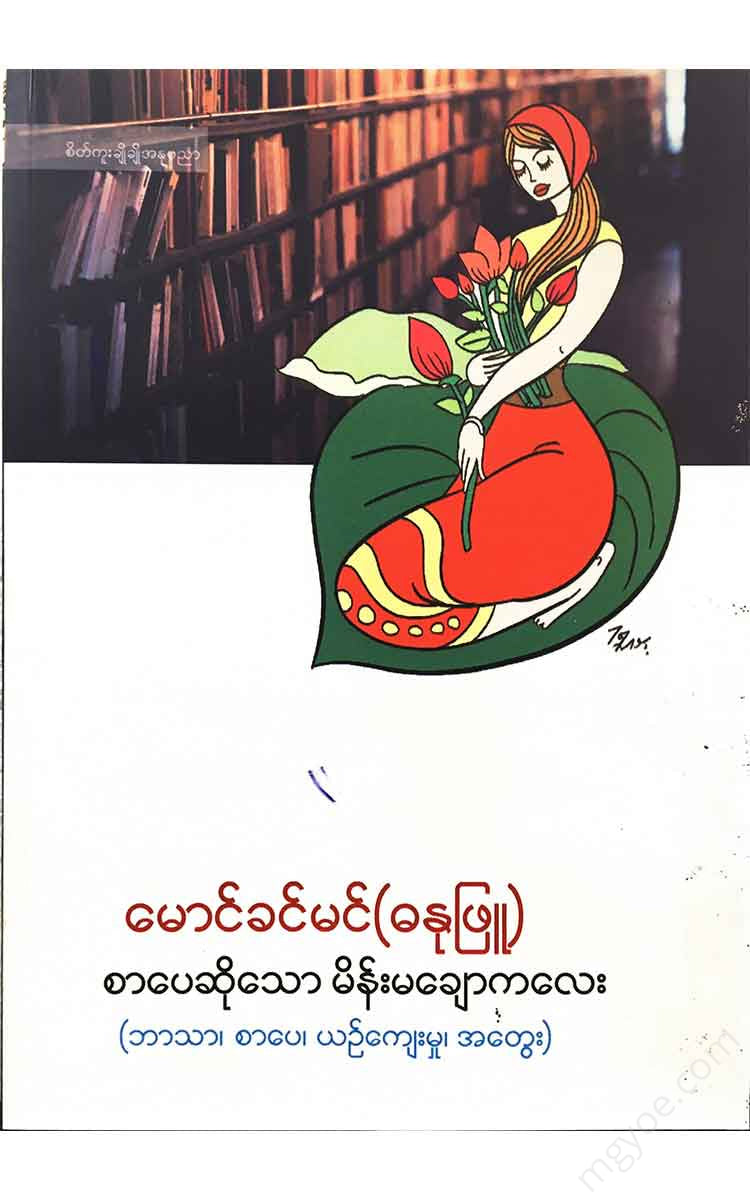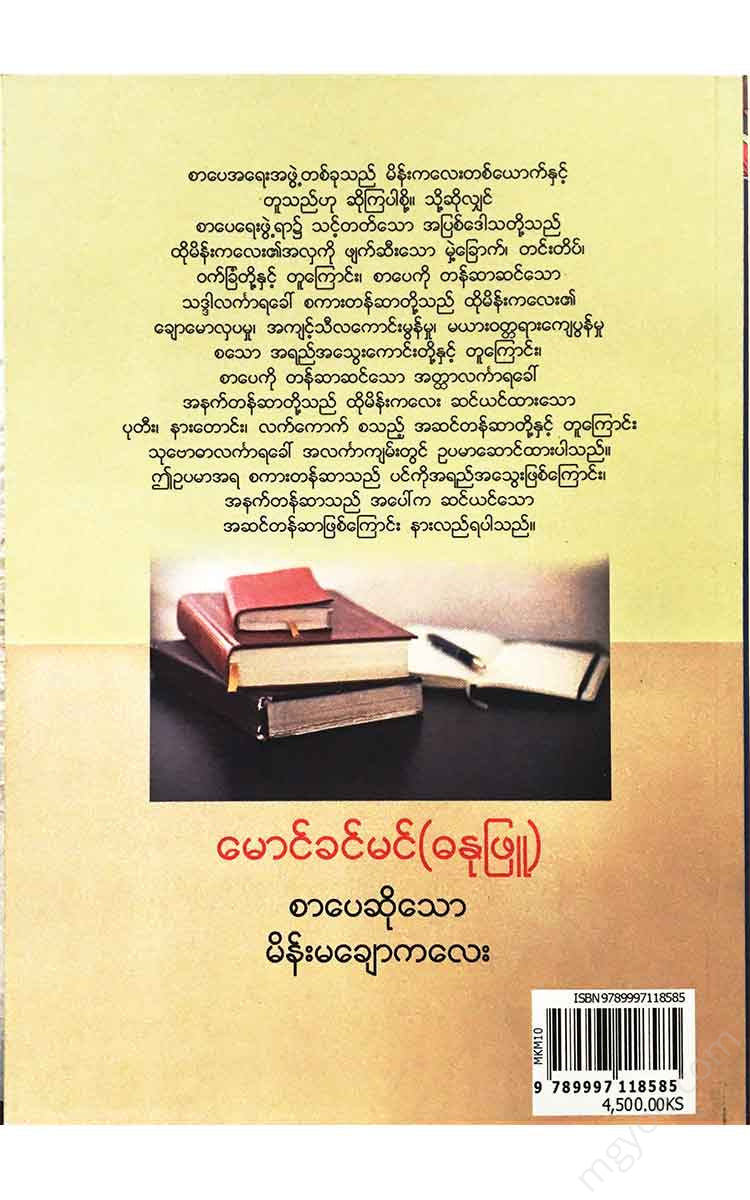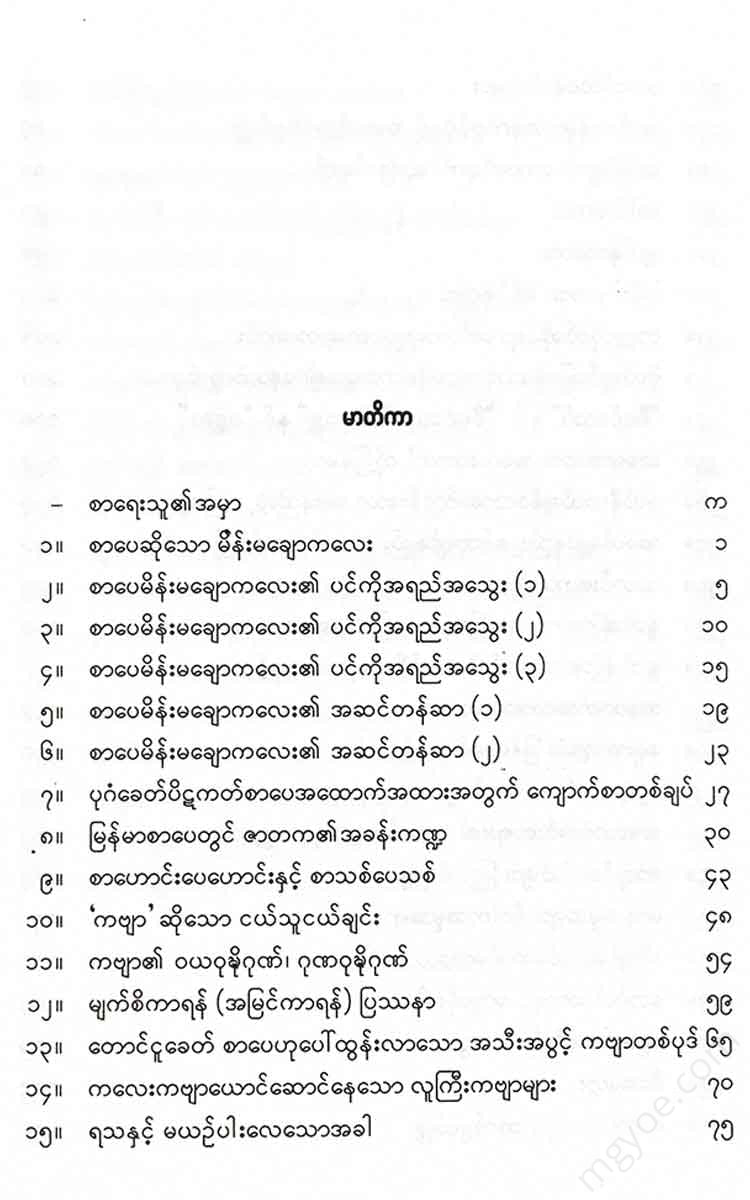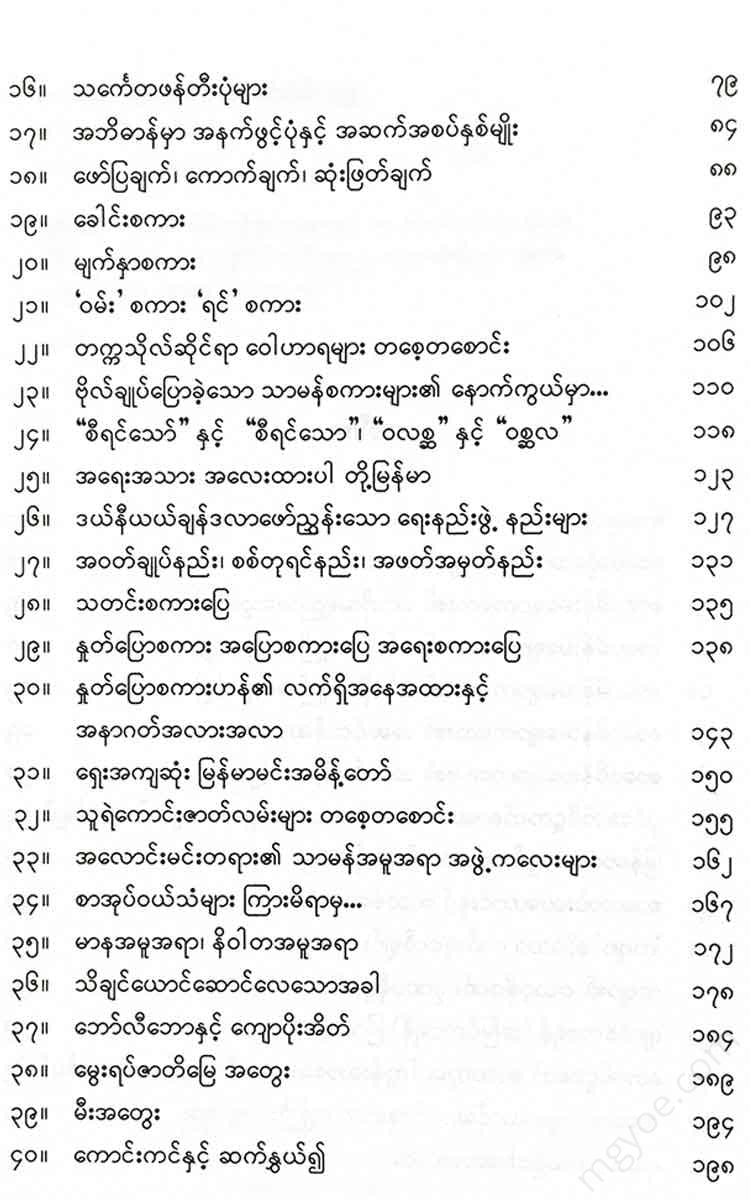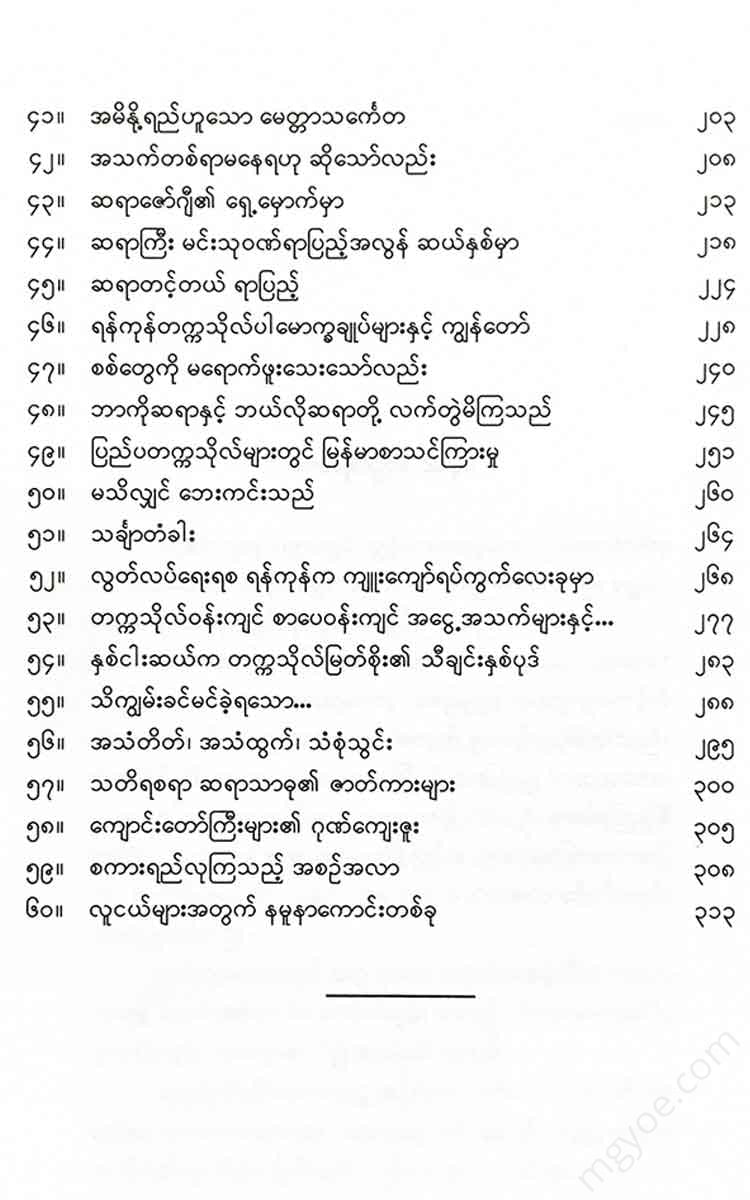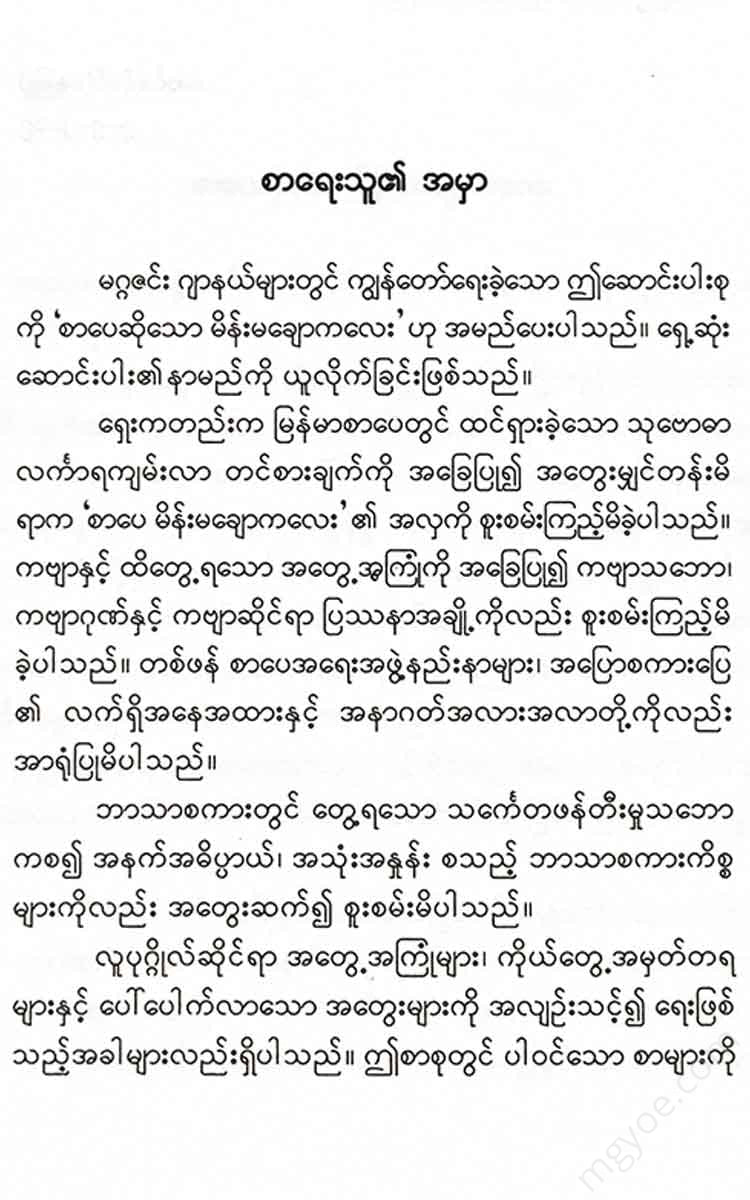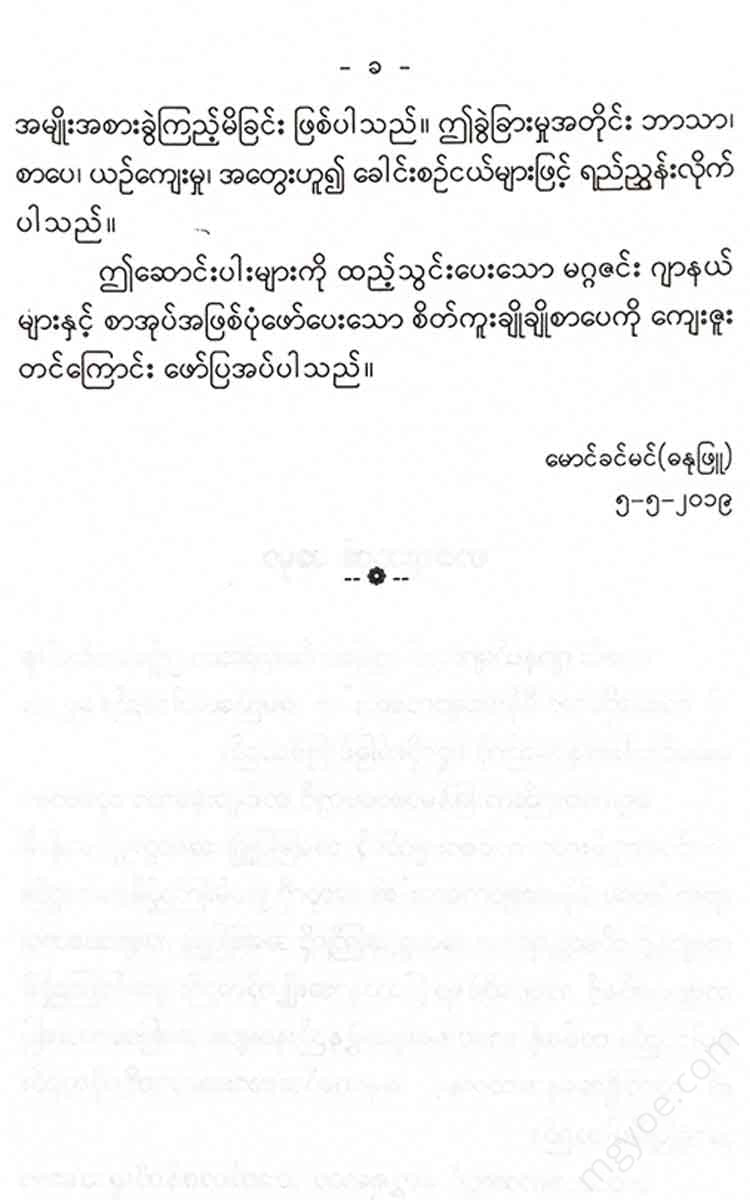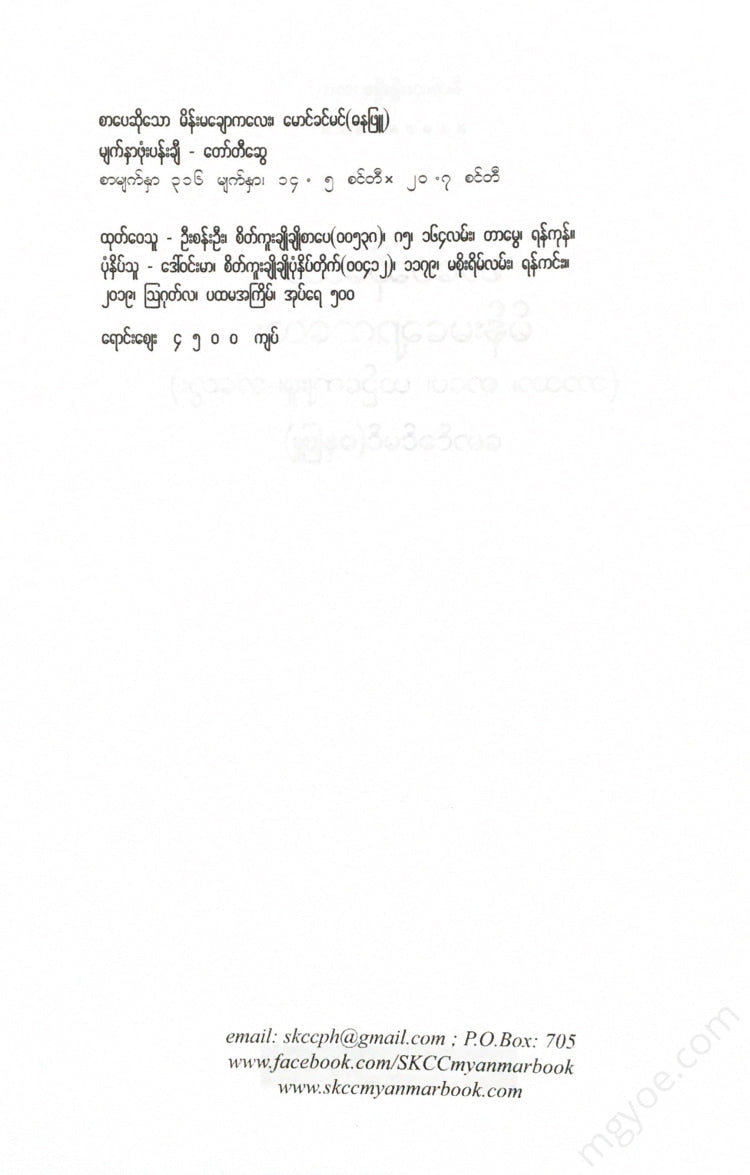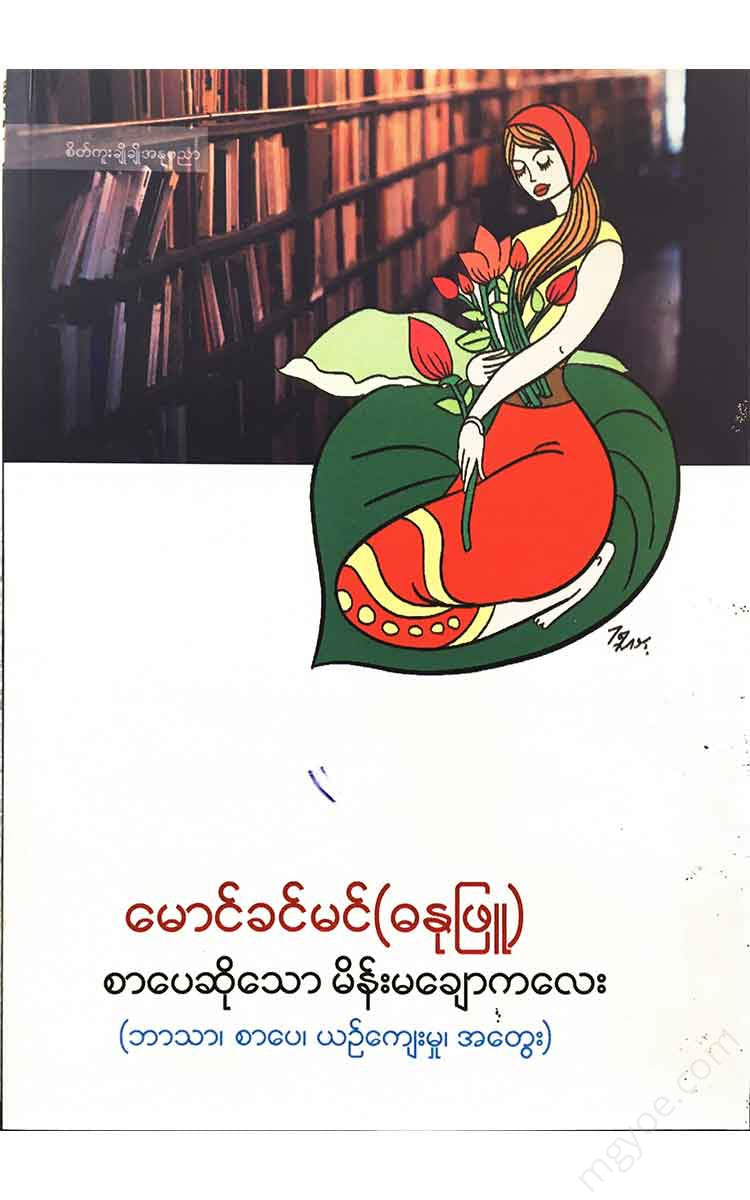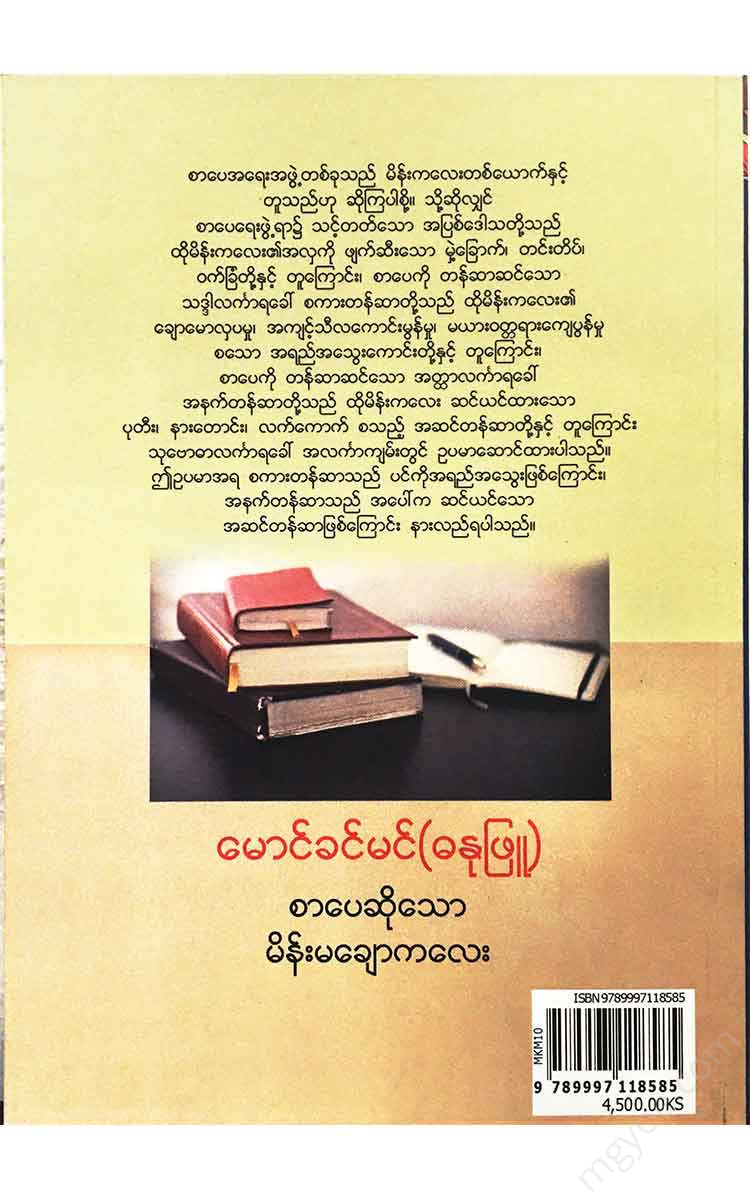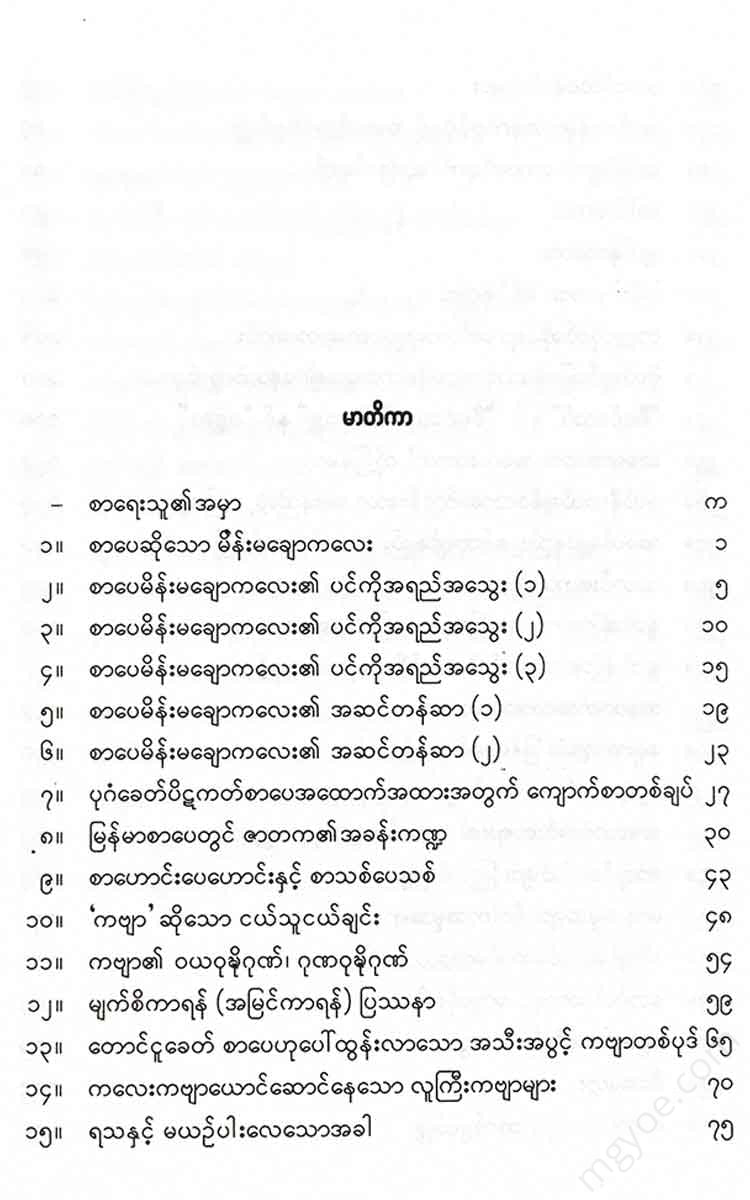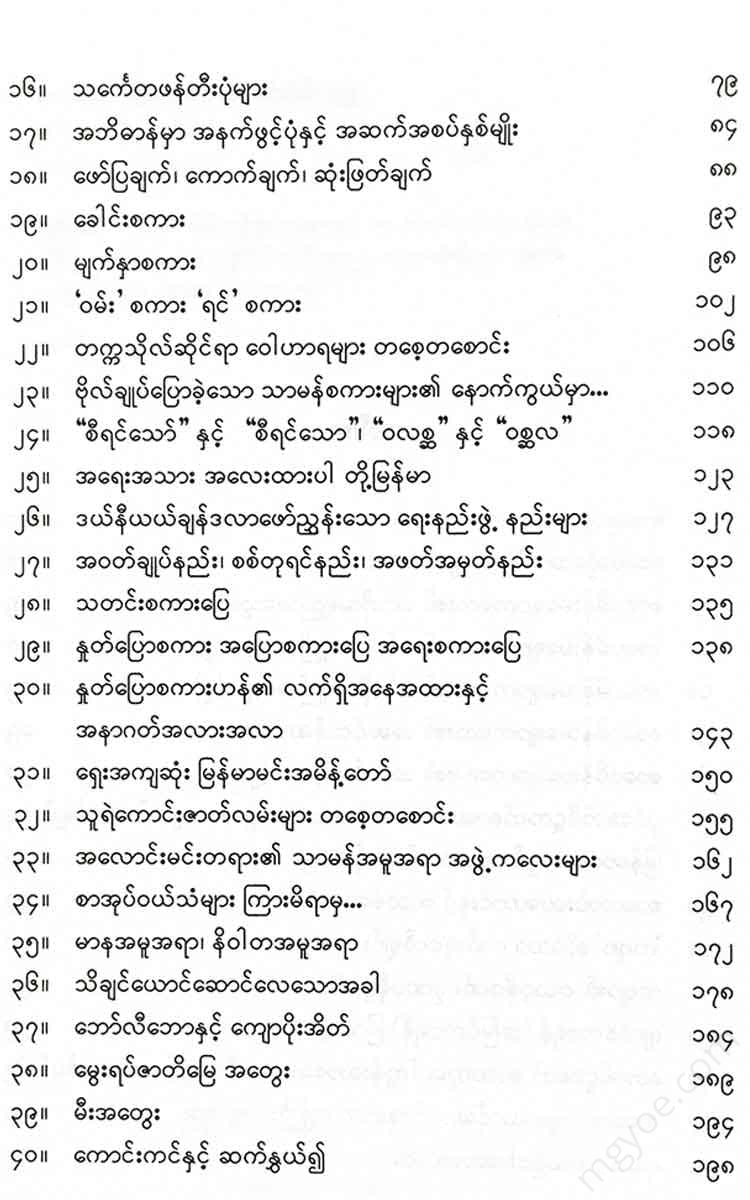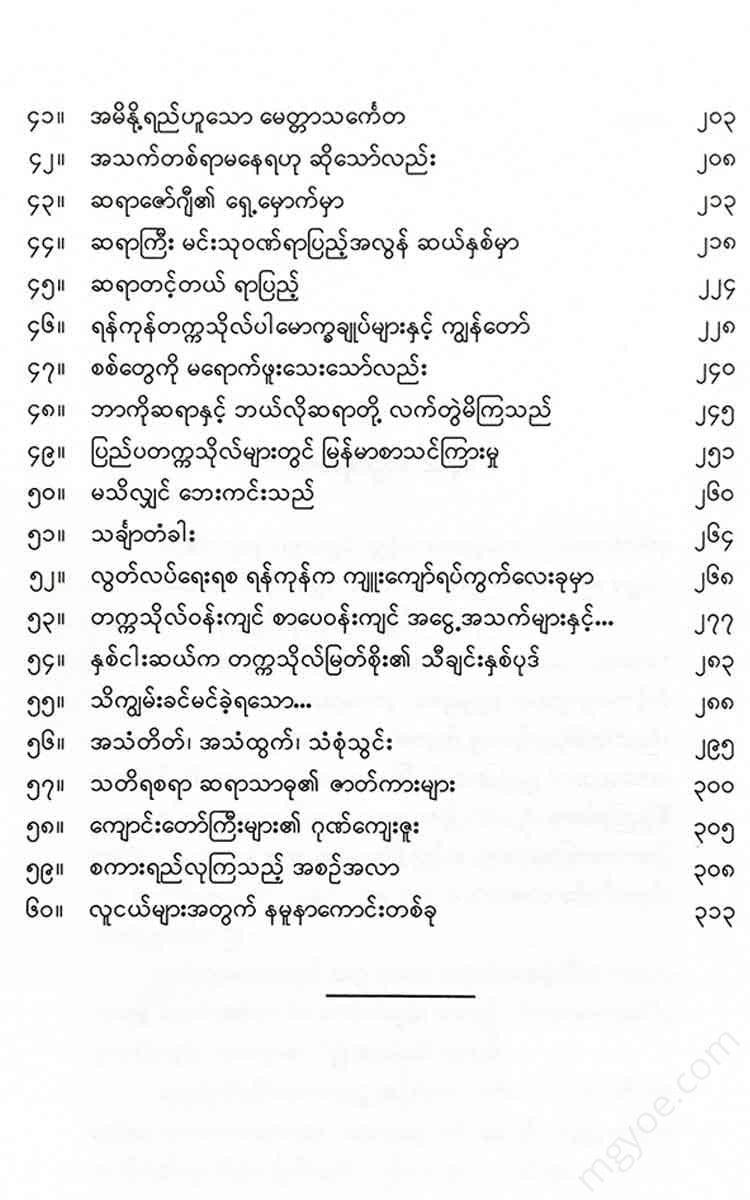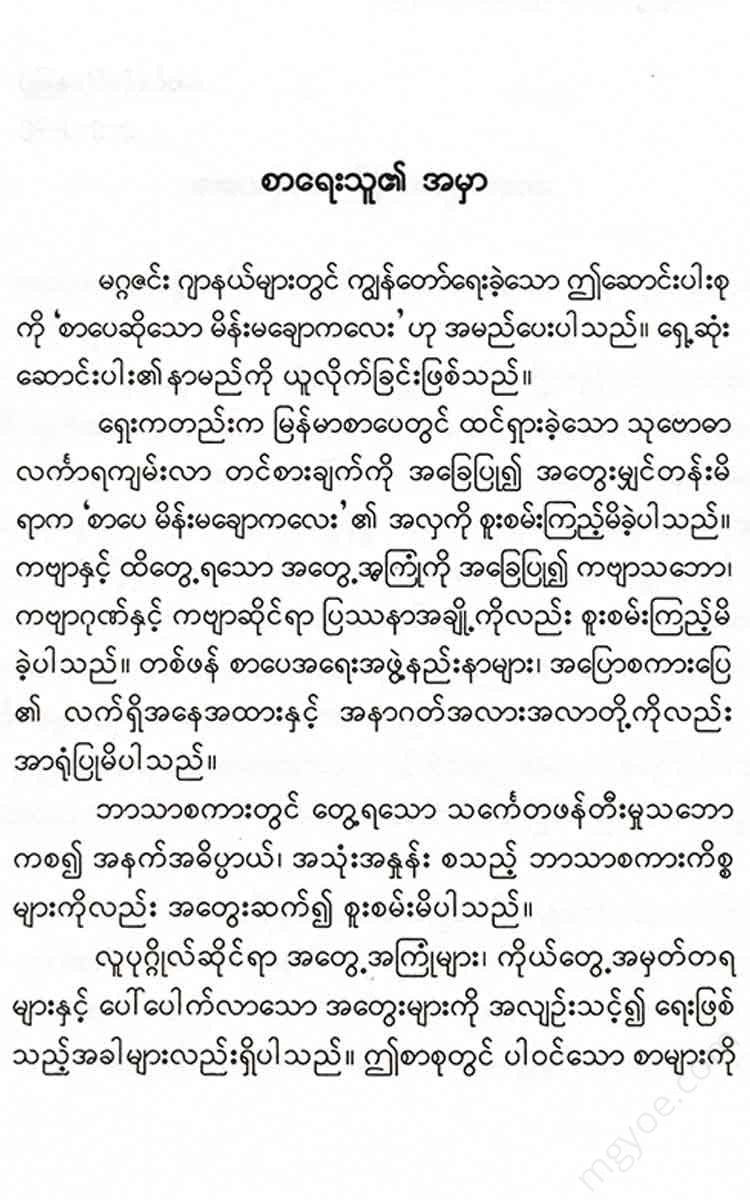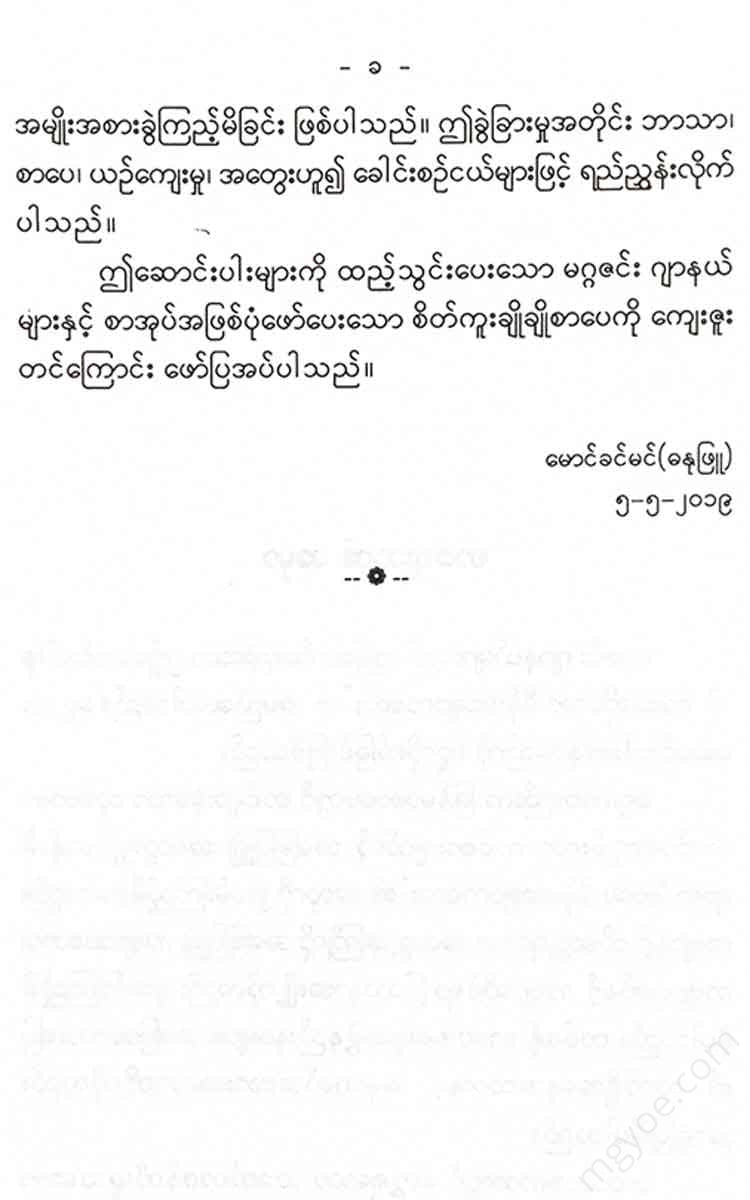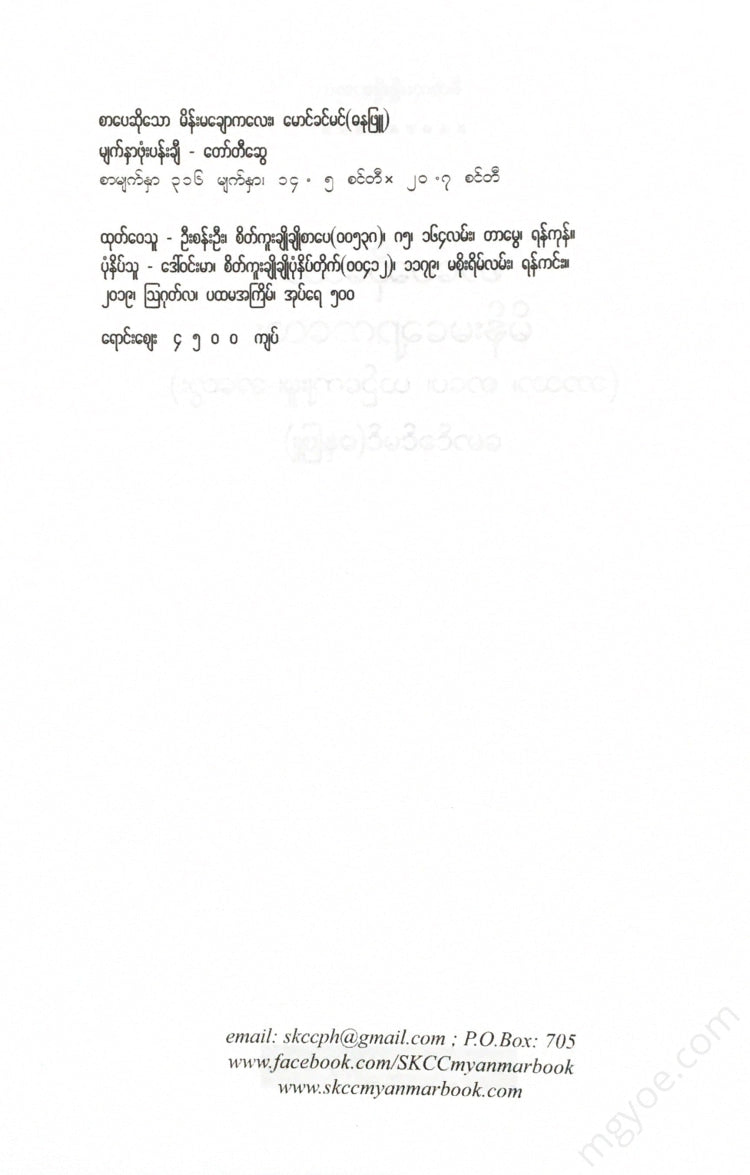စိတ်ကူးချိုချိုစာပေ
Maung Khin Min (Dhanuphuy) - A beautiful woman who speaks literature
Maung Khin Min (Dhanuphuy) - A beautiful woman who speaks literature
Couldn't load pickup availability
The beautiful woman of literature
Let us say that a literary work is like a girl. The Subodharanga text gives an example that the faults and anger that are inherent in the composition of literature are like the moles, freckles, and acne that spoil the beauty of that girl; the grammatical ornaments that adorn literature are like the girl's beauty, good conduct, and good qualities; and the subtle ornaments that adorn literature are like the beads, earrings, and bracelets that the girl wears.
From this example, we can understand that the word ornament is the intrinsic quality, and the meaning ornament is the adornment that adorns the surface.
If we examine the faults mentioned in the Alanka, we see that they are caused by the improper use of language, such as ambiguous language, use of difficult words, excessive use of words, use of meaningless words, confusion in sentences, and lack of context. If we look at the grammatical devices, we see that they are qualities that arise from mastering language, such as clarity of speech, ease of meaning, smoothness of speech, completeness of meaning, conciseness of speech, and expansion of speech to convey essence. When defining “literature,” there are definitions such as “literature is language that is well used. Literature is the creation and use of language with imagination.” If we consider these definitions in relation to them, we understand that language is the basis for literary composition, and if one is proficient in language, one can achieve excellence in literary work.
If we look at the metaphors called Atthalankāra, we see that they are metaphors that are created with imagination to create a mysterious meaning. By comparing with metaphors and comparing with physical metaphors, a subject becomes attractive. Jewelry made of diamonds, gold, and other precious stones, such as necklaces, bracelets, anklets, and earrings, makes the outfit more beautiful. These jewelry are superficial and decorative.
Another statement in the Subodharālingāra also describes the role of grammar and rhetoric. It is said that a literary work is good if it does not contain rhetorical devices (such as rhetoric such as rupaka) but is complete with rhetorical devices. On the other hand, if a literary work contains rhetorical devices but has the faults mentioned above, it will not be complete with grammar. Such a piece of writing cannot be called good writing. Therefore, the qualities that emerge from the mastery of language, called rhetoric, are essential in the composition of literature, and the ornaments that adorn the rhetorical devices to make the meaning of the poem seem strange are superficial ornaments.
Literature is composed of language. Whether it is writing a novel, a poem, a play, or an essay, language is used. As language is used more effectively to achieve literary effect, language develops based on literature. Effective and useful uses emerge. Similarly, the more language can be used effectively, the more effective literature becomes, and therefore literature also develops based on language. Language and literature are mutually beneficial partners.
The study of language and literature is also stated in the Subhodha Lankara. It is said that if a person is proficient in the four books: grammar, dictionary, diction, and rhetoric, then that person is recognized as a poet, even if he is not a writer. If we look at the four books mentioned, we see that the grammar, which explains the rules of language formation, and the dictionary, which explains the meaning of words, are linguistic books, while the Sangha, which explains how to compose Pali poetry (gatha), and the rhetoric, which explains the decorative techniques for composing a poem, are literary books.
Since there are two books on language and two books on literature, the study of language and literature is balanced. The mutual support of language and literature is reflected in the rhetorical texts that appeared before the advent of Christ.
The Alanka Book describes how a literary work can be analyzed in five parts: the section on anger, the section on how to remove anger (parihara), the section on the grammatical structure (saddalankara), the section on the semantic structure (atthalankara), and the section on the natural world (rastha). It describes how a literary work can be written with the help of verbal and semantic structures to remove anger and resentment.
It is understood that if a writer writes without guilt or anger and with honor, that writing will become a satisfying piece of writing, and the reader will experience the taste of satisfaction.
So what is the nature of rasa? What should rasa be compared to? As mentioned earlier, if we could compare a literary work that is free from faults and anger, and is complete with grammatical and semantic elements (words, meaning), to a flawless, talented, and beautiful girl, then the rasa that the reader feels is like the feeling of loving that girl.
We will continue to present how poets portray the "beautiful woman of literature."
Myawaddy Rathaseer Magazine, February, 2017.
The beauty of a literary woman (1)
We discussed the analogy of the Buddhist monk Subodhā Lankara, who compared a good scholar to a girl with a good heart and adorned with beads and ornaments.
The poet compares the girl's good moral character, her devotion to her wife, and her beauty to the ornaments of literature. Ornaments are the skillful manipulation of language to create beautiful compositions.
When compared with the definitions of "literature is language used well" and "literature is the creation and use of language," it becomes clear that the linguistic devices called rhetoric are fundamental in literary composition.
If it is characterized by "good" use of language, then the letter is certainly a pleasant letter.
According to the Alanka text, the use of language in terms of grammar (saddalankara) refers to the characteristics of clear use of language, smooth use, concise use, expansion and clarification of essence, completeness of meaning, and pleasant use of metaphors. Using language in accordance with such characteristics is considered to be “using language well.”
For example, the poems that have appeared throughout the history of Burmese literature, such as Ta Chin, Ai Chin, Luan Chin, Kok Sai Song, and Maung Taung Song, are not great works of literature belonging to the Three Kingdoms, but they are poems that are full of the aforementioned grammatical structures (saddhalangkara).
Let's take the poems of the minister of music, Padayana Raja, during the Nyaungyan period. The poem depicts a farmer's family going to the field. They happily go to the field, their cloths and shirts are torn, the farmer wears a red scarf, plows the field with a stick about a foot long, children run around in the rain without clothes, and play. After plowing the field, they pick up whatever food they can find, such as frog legs, snails, pilaw, kansun, sukpoup, and kinpon, and go home. When they get home, they quickly cook and eat hot rice and hot curry, and they make a noise while eating Shan chili peppers. The group “Nyaung Ka Pu Hin Ka Pu, Shu Shu Tha Shan Ngarot Kel and Lay” is a group that not only makes you see the scene but also hear the sound. The group eating rice and dishes in a large rice bowl is depicted in the composition “After picking the large rice bowl, the daughter and son could not enter, one knee was pushed away.”
The aikchin of Taungdwin Shin Nyein Mae, a poem of the Nyaungyan period, are also groups depicting rural nature. The young woman begins by addressing her friends as “My dear, dear friend.” In one aikchin, the two lovers have not been able to meet since the couple’s mother and stepmother disapproved of their beloved for thirteen years. In the evening, they used to talk while tying a string of rice, but the elders forbade them, so they tied the string of rice and kept it. The two lovers had not seen each other for a long time. One day, the young woman went to the farm to deliver food and when Maung returned, Maung Tha Awm met them at sunset “in front of the sedge farm and the palm tree, in a narrow bend.” At that time, Maung tied the blue headscarf that Maung Rae had given him around his neck. When he saw the young woman, he could not say a word and stood up and cried, holding Maung’s back. The young woman felt so sorry for him that she flattered him by saying, “You are a stranger to me, are you my sister?” She cursed her mother and stepmother, saying, “May the old woman who separated their love from me be hated every time she sees me, may she dry up like water.” She understood the feelings of the young woman in the pond.
In the Konbaung period, when the languishing of
The poem "The Tenth House Head" is a humorous and cheerful composition. The scene where the Tenth House Head and his wife are drinking a dish made of rattan leaves and scallion juice, holding chili peppers, and eating is described as "Great wealth, great The thatched roofed house, which is almost touching the ground, is the home of the head of the ten households. After eating, he is so tired that he cannot sleep on the "three-legged bed" and the head of the ten households is tossed and turned, and the head of the ten households is put to sleep by the head of the ten households herself. The way the story is told is very humorous. It is a simple and beautiful group.
The songs of the rice planting and the drumming are also enjoyable. The rice planting songs, the sound of the big drum, and the drumming songs are also enjoyable. When the girl who was tired and sweating from the rice planting said, “Brother, take off your waistcloth, let me wipe your sweat,” and when the girl took off her cloth and gave it to him to wipe his sweat, the girl replied, “Please, don’t wipe it, brother, don’t wipe it, don’t touch it.” When the girl returned home, the girl said with concern, “The stream is overflowing, the lake is overflowing, don’t come to meet me, or you will drown.” The groups are also beautiful and beautiful. The girls who were planting rice were also entertained by the young men’s groups playing drums and singing while cheering on the girls. The girl who came to watch the drum festival had long hair, so she said, “Come and see the drum festival, my son, you have long hair.” If the boy had long hair, he would be a great father. She would say, “My son, are you really a great father? Are you a great father?” The rice farmers would say, “I will wear gold earrings, I will wear a bomb, the big drum will lie, I will listen, ask me, don’t hide the gold, don’t hide the money, "Would you give him a golden leaf in his ear?" they said to each other, mockingly. Believing the old man's words that he would make a golden earring as big as a bomb, he had his ear enlarged, but it only got bigger. He was mocking how he had not even given the golden leaf rolled up in his ear, let alone the gold and silver.
In the Maung Taung songs, the children of the Maung Taung tell the visiting courtesans, “There is a handsome young man in front of you, with a long hair, a graceful posture, don’t act like a young man, the village is in chaos,” and the children of the Maung Taung tell the lower classes, “Come, lower classes, spread out your mats, wear three-toed sandals, and step on your chest.”
The poems presented here are simple and beautifully crafted groups of words. They are groups that use simple and beautiful language to create a literary masterpiece.
Myawaddy Rathaseer Magazine, March, 2017.
